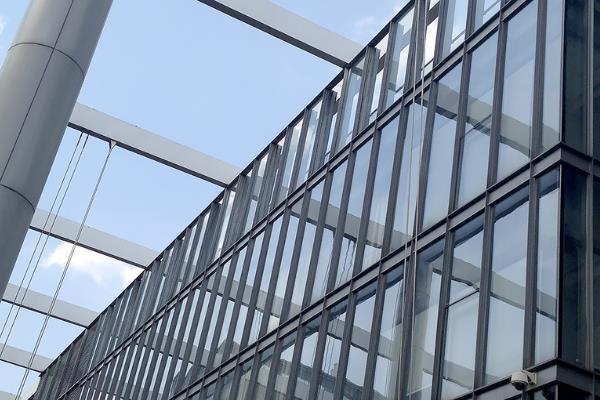Views: 6 Author: Julong Publish Time: 2023-01-09 Origin: aluminum panel systems manufacturer








Aluminum veneer curtain wall adopts high quality and high strength aluminum alloy plate, the common thickness is 1.5, 2.0, 2.5, 3.0MM, the model is 3003, and the state is H24. Its structure is mainly composed of the pre-buried plate, panel, reinforcement, and angle code. The pre-buried plate is connected with the structure through bolts to be stressed, and the corner code can be directly bent and stamped by the panel, or riveted on the small side of the panel to form the corner code. The aluminum veneer curtain wall's strength and rigidity are substantially increased by connecting the reinforcing bars with welding screws (which are directly welded on the back of the panel), which ensures the wall's flatness and long-term resistance to wind and earthquakes. Highly effective sound insulation and heat preservation materials can be put on the inside of the aluminum panel if those functions are necessary. The following are its primary attributes.
1. A curtain wall made of sturdy steel, lightweight aluminum, and high strength. The fluorocarbon paint on aluminum veneer curtain wall panels can last up to 25 years without fading and has good corrosion resistance.
2. The curtain wall process for aluminum is good. Aluminum can be treated into a variety of intricate geometric patterns, including flat, curved, and spherical shapes, by first processing and then painting.
3. Aluminum curtain walls are simple to clean and maintain and don't tarnish easily. Since the fluorine coating film is non-adhesive, pollutants have a harder time sticking to the surface, which is better for cleaning.
4. The installation and building of aluminum curtain walls are simple and rapid. At the building site, the aluminum plate in the factory molding just needs to be fixed, not cut.
5. Recycling aluminum curtain walls are good for the environment. 100% of aluminum panels may be recycled, and they have a greater recycling value.
The aluminum curtain wall has a distinctive texture, a deep, long-lasting color, and a variety of appearance shapes that blend beautifully with glass and stone curtain wall materials. Its owners like it because of its flawless appearance, outstanding quality, lightweight nature (it weighs just one-fifth as much as marble and one-third as much as a glass curtain wall), low maintenance requirements, and high price-to-performance ratio.
The great majority of composite aluminum panels and aluminum veneer are currently used in home architecture as aluminum curtain walls.
The composite aluminum plate is made of two layers of 0.5mm pure aluminum plate (0.2 to 0.25mm for indoor use) sandwiched in the middle by three to four layers of 3 to 4mm thick polyethylene (PE or PVC) using roller pressing and heat bonding. The plate's particular dimensions are 1220 mm x 2440 mm. Outside the surface of the composite aluminum plate, fluorocarbon paint is also applied using roller coating and roller pressing, followed by heat bonding to complete the coating. The benefits of a composite aluminum plate include its lightweight, smooth surface, good flatness, lack of color difference in the same direction, and excellent field processability, which creates the conditions for handling the change in exterior wall size brought on by on-site construction error, shortening the processing time in the workshop, and reducing the time needed for installation.
When installing composite aluminum plates for wall panels, the size of the secondary design should be taken into consideration when cutting the plates. Generally, this means adding about 30 mm per side, and according to the curtain wall installation company, cutting the plates at a general rate of 60% to 70%. Plan the groove on all sides of the composite board, that is, cut off a particular width of the inner layer of aluminum and plastic layer, only 0.5mm thick outer layer of metal. Fold the edge into a 90-degree angle, and then use metal profiles to create a pay frame the same size as the aluminum-plastic plate bent slot. Pay the frame's bottom with structural adhesive bonded to the back of the aluminum-plastic plate, then fold up the four sides with the shape of rivets fixed on the exterior of the play frame. Reinforcing bars are usually installed in the center of the frame to assure the mechanical strength of the wall panel. The reinforcement is aluminum, with structural adhesive bonding, some informal practice just in the corners of the composite board plus corner metal fixed, reinforcement bonding with double-sided adhesive tape, substantially reduced solidity.
When making an aluminum veneer into a wall plate, the sheet metal processing is carried out first according to the requirements of secondary design, and the edges are folded directly, the four corners are welded into a dense groove by high pressure, and the reinforcement fixing bolts are reserved on the back of the wall plate using welding nail planting. An aluminum veneer is easily processed into curved and multi-folded edges or sharp corners to satisfy the needs of today's ever-changing exterior wall decorating, and the rich hues may be chosen at whim according to the design and owner's requirements, genuinely broadening architects' design space.